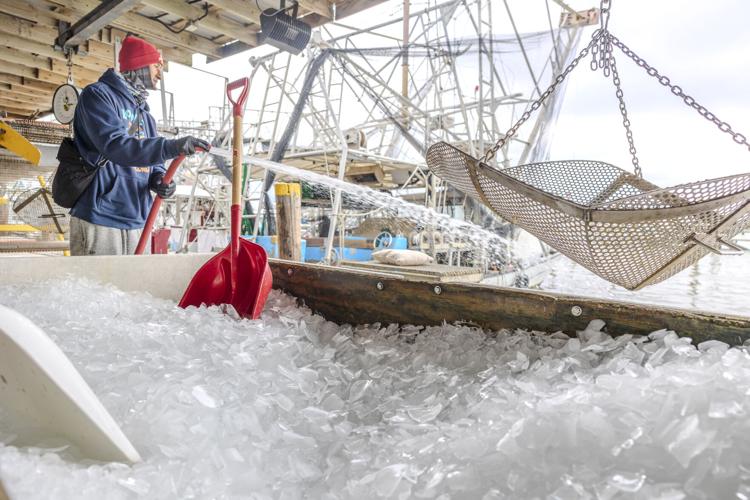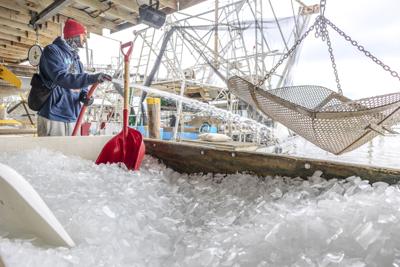The threat of saltwater intrusion moving up the Mississippi River last year sent New Orleans and its neighbors scrambling for solutions to protect drinking water, but it also posed deeper questions about whether the problem was worsening and what potential long-term solutions might be pursued.
New research is beginning to answer some of those questions, and the results are both concerning and, in some ways, hopeful.
It turns out the problem has indeed become more severe, new modeling suggests. And the reasons are separate from drought or a lack of snowfall farther north causing a low and slow Mississippi, which allows saltwater to travel upriver from the Gulf.
Instead, researchers are looking at multiple factors, including sea level rise and the natural breaks in the river that have formed below New Orleans. The deepening of the Mississippi for shipping has also long been acknowledged as worsening saltwater intrusion, but new models are looking at that in conjunction with other factors.
Scientists are also exploring solutions, including one potentially innovative idea that could also build land in a state fast losing it.
Researchers have been pointing out that last year’s river was low, but not historically low. And yet the saltwater intrusion was particularly severe, meaning other factors were contributing.
“It is the river itself that has changed over time,” said Ehab Meselhe, a Tulane professor who recently presented modeling from his team on what is typically referred to as the saltwater wedge. “So we're trying to see now: What are the factors that contribute to that change in the river response?”
One of his team’s most striking conclusions involved modeling that compared conditions in 2023 to 1994 data, though Meselhe warned that the result was only approximate. It found that if water conditions had been the same and no sill had been built to block the salt water, the wedge would have advanced about 20 miles farther upriver in 2023.
Gary Brown of the Engineer Research and Development Center, an arm of the Army Corps of Engineers, also found in his modeling that low flow alone “doesn't appear to be fully explaining why we had such a significant intrusion event.”
The research touches on a list of issues at the heart of south Louisiana’s existence, including drinking water, land loss and one of the world's busiest shipping channels. Both Brown and Meselhe recently presented their findings to a symposium hosted by Tulane's Department of River-Coastal Science and Engineering.

A home backs up to the Mississippi River levee next to where the U.S. Army Corps of Engineers was building an underwater sill with mud to slow the flow of saltwater on Sept. 26, 2023.
Deepening the problem
The typical flow of the Mississippi is strong enough to prevent salt water from moving up the channel from the Gulf. But when flows are particularly low, it can move up in the form of a wedge.
Salt water is heavier than fresh, so it extends along the river bottom, its volume increasing behind its initial “toe,” in the shape of a doorstop. The Mississippi’s bottom is below sea level from the river’s mouth up to Natchez, which helps allow it to happen.
It has long been a problem, even back in the 1930s, but continued dredging of the river has appreciably worsened the situation. It was deepened to 45 feet in 1986 and to 50 feet a couple years ago.
When Congress authorized the Corps of Engineers to move ahead with those projects in the 1980s to accommodate larger ships, there were warnings and acknowledgements that saltwater intrusion would be an issue. To account for the increased threat, the Corps developed the idea of building a sill, or underwater levee, along the river bottom to slow the salt water’s advance.
The sill, which gradually erodes, has been built five times since 1988, but last year it failed to slow the wedge enough. The Corps then built it taller while leaving a notch in the middle to continue to allow for shipping.
Lower Plaquemines Parish dealt with the problem for months, using a combination of solutions to ensure drinking water supplies. But initial predictions that the salt water would reach New Orleans and beyond, which set off a scramble to plan for temporary pipelines, did not come to pass.
Brown’s analysis, using a model named MR SWAT, points to three factors last year: low water, the deepening of the river and the breaks in the lower river’s banks, or crevasses. Those include large breaks, such as Neptune Pass across from Buras, and smaller ones, like Mardi Gras Pass downriver of Pointe a la Hache.

A ship travels down the Mississippi River, past Neptune Pass near Bohemia, La., Saturday, June 3, 2023. New research says natural breaks in the river such as Neptune Pass are having an effect on saltwater intrusion in addition to the deepening of the Mississippi for shipping. (Flight courtesy of SouthWings)
Four breaks along the river’s east bank south of New Orleans along with other smaller ones can take together 30% to 40% of the Mississippi’s flow, Brown says. That in turn reduces the river’s power to push back on the salt water. Additional salt water entering the river through those breaks is not so much of a concern, said Brown.
“The low water, the channel deepening and the number of crevasses — the number of places for water to more freely exchange with the Gulf other than the main river — all of those things contribute significantly,” Brown said.
He notes that his model, too, is fairly simple and not exact, but it serves as an effective guide. Both he and Meselhe say further research is warranted.
‘The river is responding differently’
The modeling by Meselhe’s team was less conclusive on the role of the river breaks; he said that they may at times help to remove salt from the river. They also looked at sea level rise, and found that it was having an effect, but not a dominant one.
“It's one of the three or all three, and maybe there are other reasons that I cannot think of at the moment,” Meselhe said of sea level rise, the deeper channel and a weakened flow. “So we wanted to examine and we are still examining the relative contribution of these three possible drivers for the difference in why the river is responding differently.”
Meselhe sketched out a potential solution that would seem to satisfy many. The idea would be to build a sill at the entrance to a crevasse when needed that would prevent too much of the river flow being diverted. When the river runs high again, the sill would be eroded, and the sediment would wash farther down the channel, potentially building land.
Coastal advocates have fought to keep the crevasses open because of their ability to build land the way the river used to before levees hemmed it in. The Corps, however, is concerned over their effect on shipping, at least in certain cases.
Brown says he and his colleagues are exploring the kinds of options that Meselhe proposed.
Michael Hopkins, science director for the Pontchartrain Conservancy, has closely studied the river’s crevasses. He says the state will have to find ways to use “adaptive management” — solutions that use nature instead of working against it, and that can evolve over time.
“We have to look at everything,” said Hopkins. “Our land-loss crisis is happening every year — every day.”
Corps spokesperson Ricky Boyett says the agency is looking carefully at what happened last year, both in terms of short-term and long-term solutions. He says it seemed the heightened sill worked better than initially predicted.
The Corps is also in the process of carrying out a five-year study looking at the entire management of the lower river, and that will also include saltwater intrusion issues.
“We're looking at it from a perspective of, ‘What's the best approach if there is another low water year this year, or the next year or two?’” Boyett said. “But also, that is definitely something that is a component that we have to consider for the long-term sustainable and resilient river system that we're going to try and achieve.”







